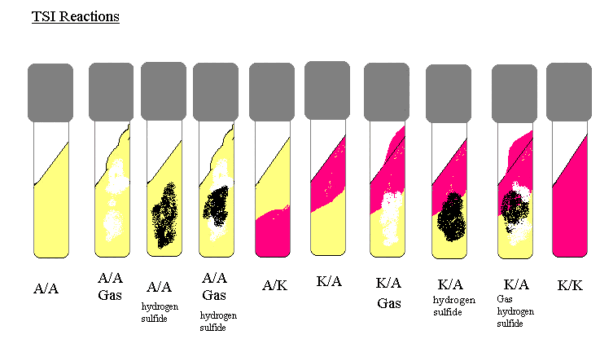Triple sugar iron agar (TSI) / TSIA Test is a very versatile and indispensable tool in the field of microbiology. With its ability to differentiate enteric bacteria based on carbohydrate fermentation and hydrogen sulfide production, TSI plays a crucial role in bacterial identification, clinical diagnosis, and research efforts. This comprehensive medium contains lactose, sucrose, glucose, ferrous sulfate, and phenol red, providing a rich substrate for assessing bacterial metabolic activities.
TSIA test principle
The underlying principle of the Triple Sugar Iron (TSI) agar test revolves around its differential abilities to discern between various Gram-negative enteric pathogens based on their metabolic activities. This medium contains three crucial components: triple sugars (lactose, sucrose and glucose), a pH indicator (phenol red), and ferrous sulfate. Each component has a specific purpose in facilitating the differentiation of bacterial strains.
Triple sugars (lactose, sucrose and glucose):
These carbohydrates serve as substrates for bacterial fermentation. Bacteria with enzymatic machinery to metabolize these sugars will use them as an energy source, leading to the production of acidic byproducts. The use of different sugars produces characteristic color changes in the medium, which helps identify metabolic capacities.
pH indicator (phenol red):
Phenol red acts as a pH indicator, changing color in response to alterations in the pH of the medium. Initially, TSI agar has a reddish-orange color, indicating a neutral pH. As bacteria ferment sugars and produce acidic byproducts, the pH of the medium decreases, causing phenol red to change from yellow (acidic pH) to red (basic pH). This color change provides visual cues about the bacteria's fermentation patterns.
Iron sulphate:
Ferrous sulfate serves a dual purpose in the TSI agar test. Firstly, it acts as a substrate for the detection of hydrogen sulfide (H2S) production by certain bacterial species. Bacteria capable of reducing sulfur compounds present in the medium produce hydrogen sulfide gas, which reacts with ferrous sulfate to form a black precipitate of ferrous sulfide. This blackening of the medium serves as an indicator of H2S production. Secondly, ferrous sulfate also helps detect gas production by bacteria. As gas is produced during sugar fermentation, it can manifest as bubbles or cracks in the medium, providing additional diagnostic information.
By incorporating these components into TSI agar medium, microbiologists can exploit the metabolic diversity of enteric pathogens to differentiate between various bacterial strains. Interpretation of TSI agar results is based on the observation of color changes, gas production, and formation of black precipitates, allowing microbiologists to make informed decisions regarding the identification and classification of bacteria.
Interpretation of TSIA test results:
Interpretation of TSIA test results involves careful observation of color changes and precipitate formations within the medium. These observations provide valuable information on bacterial metabolic profiles. The following table describes the interpretation of different combinations of ETI results:

| Result (tilt/full) | Symbol | Interpretation |
| Red Yellow | K/A | Only glucose fermentation, peptone catabolization. |
| Yellow/Yellow | AA | Fermentation of glucose and lactose and/or sucrose. |
| Red Red | K/K | Without fermentation, catabolized by peptone. |
| Yellow/Yellow with bubbles | A/A,G | Fermentation of glucose and lactose and/or sucrose, Gas is produced. |
| Red/Yellow with bubbles | K/A,G | Only glucose fermentation, gas production. |
| Red/Yellow with bubbles and black precipitate. | K/A,G,H2S | Only glucose fermentation, gas production, H2S production. |
| Yellow/Yellow with bubbles and black precipitate. | A/A,G,H2S | Fermentation of glucose and lactose and/or sucrose, gas production, H2S production. |
| Red/Yellow with black precipitate | K/A,H2S | Only glucose fermentation, H2S is produced. |
| Yellow/Yellow with black precipitate | A/C, H2S | Fermentation of glucose and lactose and/or sucrose, H2S is produced. |
Expected results and examples of bacteria in the TSIA test:
- Red leaning/yellow ass (K/A):
- Example bacteria: Citrobacter freundii, Citrobacter koseri, Morganella morganii.
- Yellow Slant/Yellow Ass (A/A):
- Example bacteria: Escherichia coli, Enterobacter aerogenes, Klebsiella oxytoca.
- Red Tilt/Red Tail (K/K):
- Example bacteria: Acinetobacter spp., Pseudomonas spp.
- Tilted Yellow/Red Head with Gas (A/A, G):
- Example bacteria: Escherichia coli, Enterobacter aerogenes, Klebsiella pneumoniae.
- Slanted red/yellow background with gas and black precipitate (K/A, G, H2S):
- Example bacteria: Citrobacter freundii, Proteus mirabilis.
- Yellow inclined/Yellow head with gas and black precipitate (A/A, G, H2S):
- Example bacteria: Proteus mirabilis, Proteus vulgaris.
- Red slope/Yellow tail with black precipitate (K/A, H2S):
- Example bacteria: Citrobacter freundii, Salmonella spp.
- Yellow slope/Yellow tail with black precipitate (A/A, H2S):
- Example bacteria: Proteus mirabilis, Proteus vulgaris.
Distinctive features of TSI results:
- Color changes: Indicate the use of specific sugars and pH alterations.
- Gas production: It manifests itself as bubbles or cracks in the agar medium.
- H2S production: It leads to the formation of a black precipitate in the medium.
Practical considerations:
- Incubate TSI tubes at 37°C for 18-24 hours for optimal results.
- Prolonged incubation can distort interpretations and affect the reliability of results.
TSIA Recipe:
Ingredients:
- Pancreatic casein digest USP: 10.0 g
- Peptic digest of animal tissue USP: 10.0 g
- Glucose: 1.0 g
- Lactose: 10.0 g
- Sucrose: 10.0 g
- Ferrous sulfate or ferrous ammonium sulfate: 0.2 g
- Sodium chloride (NaCl): 5.0 g
- Sodium thiosulfate: 0.3 g
- Phenol red: 0.024 g
- Agar: 13.0 g
- Distilled water: 1,000 mL
Instructions:
- Mix all ingredients in distilled water.
- Adjust the pH to 7.3.
- Boil until dissolved.
- Autoclave at 121°C for 15 minutes.
- Cool and dispense into tubes with an inclined position.
- Solidify for use in bacterial culture.
Storage: Keep in a cool, dry place away from sunlight.
This recipe creates TSIA agar, which makes it easy to detect carbohydrate fermentation and H2S production in bacteria, which aids in microbial identification.
Importance of the TSIA test in microbiological research and diagnosis:
The Triple Sugar Iron Agar test has immense importance in microbiological diagnosis and research for several reasons:
- Bacterial identification: TSI allows differentiation of bacterial strains based on their metabolic capabilities, which helps in bacterial identification and classification.
- Clinical relevance: TSI results inform clinical interventions, particularly in the diagnosis of gastrointestinal infections caused by enteric bacteria, guiding treatment strategies and preventing the spread of disease.
- Microbial Ecology Studies: The TSI agar test is essential in microbial ecology studies as it provides information on the diversity and metabolic activities of bacterial communities in different environments.
- Research tool: The TSI agar test serves as a valuable research tool to study bacterial metabolism, adaptive mechanisms, and virulence factors, contributing to our understanding of bacterial physiology.
- QA: The TSI agar test is used for quality control purposes in clinical and industrial settings, ensuring the purity and safety of various products by detecting potential enteric pathogens.
Conclusion:
In summary, the Triple Sugar Iron Agar test stands as a fundamental technique in microbiology, offering valuable information on bacterial metabolic profiles and aiding in bacterial identification, clinical diagnosis, and research efforts. Through meticulous interpretation and adherence to best practices, the TSI agar test continues to play a critical role in advancing our understanding of microbial communities and their implications for human health.
Learn more;













Leave feedback about this